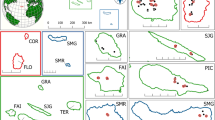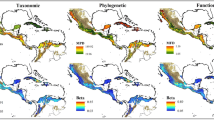Abstract
The Circumpolar Biodiversity Monitoring Programme (CBMP) provides an opportunity to improve our knowledge of Arctic arthropod diversity, but initial baseline studies are required to summarise the status and trends of planned target groups of species known as Focal Ecosystem Components (FECs). We begin this process by collating available data for a relatively well-studied region in the Arctic, the North Atlantic region, summarising the diversity of key terrestrial arthropod FECs, and compiling trends for some representative species. We found the FEC classification system to be challenging to implement, but identified some key groups to target in the initial phases of the programme. Long-term data are scarce and exhibit high levels of spatial and temporal variability. Nevertheless, we found that a number of species and groups are in decline, mirroring patterns in other regions of the world. We emphasise that terrestrial arthropods require higher priority within future Arctic monitoring programmes.
Similar content being viewed by others
References
Aastrup, P., J. Nymand, K. Raundrup, M. Olsen, T. L. Lauridsen, P.H. Krogh, N.M. Schmidt, and L. Illeris, et al. 2015. Conceptual design and sampling procedures of the biological programme of NuukBasic., Aarhus University.
Arnalds, A. 1987. Ecosystem disturbance in Iceland. Arctic and Alpine Research 19: 508–513.
Ávila-Jiménez, M.L., and S.J. Coulson. 2011. A holarctic biogeographical analysis of the Collembola (Arthropoda, Hexapoda) Unravels recent post-glacial colonization patterns. Insects 2: 273.
Barrio, I.C., C.G. Bueno, and D.S. Hik. 2016. Warming the tundra: Reciprocal responses of invertebrate herbivores and plants. Oikos 125: 20–28.
Barrio, I.C., E. Lindén, M. Te Beest, J. Olofsson, A. Rocha, E.M. Soininen, J.M. Alatalo, T. Andersson, et al. 2017. Background invertebrate herbivory on dwarf birch (Betula glandulosa-nana complex) increases with temperature and precipitation across the tundra biome. Polar Biology 40: 2265–2278.
Böcher, J. 1988. The Coleoptera of Greenland—Meddelelser om Grønland. BioScience 26: 100.
Böcher, J., N.P. Kristensen, T. Pape, and L. Vilhelmsen (eds.). 2015. The greenland entomofauna: An identification manual of insects, spiders and their allies. Leiden, The Netherlands: Koninklijke Brill nv.
Bolduc, E., N. Casajus, P. Legagneux, L. McKinnon, H.G. Gilchrist, M. Leung, R.I.G. Morrison, D. Reid, et al. 2013. Terrestrial arthropod abundance and phenology in the Canadian Arctic: modelling resource availability for Arctic-nesting insectivorous birds. Canadian Entomologist 145: 155–170.
Bowden, J.J., A. Eskildsen, R.R. Hansen, K. Olsen, C.M. Kurle, and T.T. Hoye. 2015a. High-arctic butterflies become smaller with rising temperatures. Biology Letters 11: 20150574.
Bowden, J.J., O.L.P. Hansen, K. Olsen, N.M. Schmidt, and T.T. Høye. 2018. Drivers of inter-annual variation and long-term change in High-Arctic spider species abundances. Polar Biology 41: 1635–1649.
Bowden, J.J., R.R. Hansen, K. Olsen, and T.T. Hoye. 2015b. Habitat-specific effects of climate change on a low-mobility Arctic spider species. Polar Biology 38: 559–568.
Brussaard, L., M.M. Pulleman, É. Ouédraogo, A. Mando, and J. Six. 2007. Soil fauna and soil function in the fabric of the food web. Pedobiologia 50: 447–462.
Callaghan, T.V., L.O. Bjorn, Y. Chernov, T. Chapin, T.R. Christensen, B. Huntley, R.A. Ims, M. Johansson, et al. 2004. Biodiversity, distributions and adaptations of arctic species in the context of environmental change. Ambio 33: 404–417.
CAVM Team. 2003. Circumpolar Arctic Vegetation Map. Scale 1:7,500,000. Conservation of Arctic Flora and Fauna (CAFF) Map No. 1., U.S. Fish and Wildlife Service, Anchorage.
Christensen, T., J. Payne, M. Doyle, G. Ibarguchi, J. Taylor, N. M. Schmidt, M. Gill, M. Svoboda, M. et al. 2013. The Arctic Terrestrial Biodiversity Monitoring Plan. 7, CAFF International Secretariat. Akureyri, Iceland.
Convey, P., S.J. Coulson, M.R. Worland, and A. Sjöblom. 2018. The importance of understanding annual and shorter-term temperature patterns and variation in the surface levels of polar soils for terrestrial biota. Polar Biology.
Coulson, S.J., P. Convey, K. Aakra, L. Aarvik, M.L. Avila-Jimenez, A. Babenko, E.M. Biersma, S. Bostrom, et al. 2014. The terrestrial and freshwater invertebrate biodiversity of the archipelagoes of the Barents Sea, Svalbard, Franz Josef Land and Novaya Zemlya. Soil Biology & Biochemistry 68: 440–470.
Culler, L.E., M.P. Ayres, and R.A. Virginia. 2015. In a warmer Arctic, mosquitoes avoid increased mortality from predators by growing faster. Proceedings of the Royal Society B-Biological Sciences 282: 20151549.
Danks, H.V. 1981. Arctic Arthropods. A review of systematics and ecology with particular reference to the North American fauna. Entomological Society of Canada, Ottawa.
Danks, H.V. 1992. Arctic insects as indicators of environmental-change. Arctic 45: 159–166.
Franke, A., V. Lamarre, and E. Hedlin. 2016. Rapid nestling mortality in arctic peregrine falcons due to the biting effects of black flies. Arctic 69: 281–285.
Gaston, A.J., J.M. Hipfner, and D. Campbell. 2002. Heat and mosquitoes cause breeding failures and adult mortality in an Arctic-nesting seabird. Ibis 144: 185–191.
Gauld, I.D., and B. Bolton. 1988. The hymenoptera. London: Oxford University Press.
Gillespie, M.A.K., N. Baggesen, and E.J. Cooper. 2016. High Arctic flowering phenology and plant-pollinator interactions in response to delayed snow melt and simulated warming. Environmental Research Letters 11: 115006.
Govoni, D.P., B.K. Kristjansson, and J.S. Olafsson. 2018. Spring type influences invertebrate communities at cold spring sources. Hydrobiologia 808: 315–325.
Halldorsson, G., B.D. Sigurdsson, B. Hrafnkelsdottir, E.S. Oddsdottir, O. Eggertsson, and E. Olafsson. 2013. New arthropod herbivores on trees and shrubs in Iceland and changes in pest dynamics: A review. Icelandic Agricultural Sciences 26: 69–84.
Hallmann, C.A., M. Sorg, E. Jongejans, H. Siepel, N. Hofland, H. Schwan, W. Stenmans, A. Müller, et al. 2017. More than 75 percent decline over 27 years in total flying insect biomass in protected areas. PLoS ONE 12: e0185809.
Hansen, R.R., O.L.P. Hansen, J.J. Bowden, U.A. Treier, S. Normand, and T. Hoye. 2016. Meter scale variation in shrub dominance and soil moisture structure Arctic arthropod communities. Peerj 4: e2224.
Hodkinson, I.D., A. Babenko, V. Behan-Pelletier, J. Böcher, G. Boxshall, F. Brodo, S.J. Coulson, W.H. De Smet, et al. 2013. Terrestrial and Freshwater Invertebrates.in H. e. a. Meltofte, editor. Arctic Biodiversity Assessment. Status and trends in Arctic biodiversity, Conservation of Arctic Flora and Fauna, Akureyri.
Hodkinson, I.D., and S.J. Coulson. 2004. Are high Arctic terrestrial food chains really that simple? The Bear Island food web revisited. Oikos 106: 427–431.
Hodkinson, I.D., S.J. Coulson, and N.R. Webb. 2004. Invertebrate community assembly along proglacial chronosequences in the high Arctic. Journal of Animal Ecology 73: 556–568.
Høye, T.T., and L.E. Culler. 2018. Tundra arthropods provide key insights into ecological responses to environmental change. Polar Biology 41: 1523–1529.
Høye, T.T., E. Post, H. Meltofte, N.M. Schmidt, and M.C. Forchhammer. 2007. Rapid advancement of spring in the High Arctic. Current Biology 17: 449–451.
Høye, T.T., and D.S. Sikes. 2013. Arctic entomology in the 21st century. Canadian Entomologist 145: 125–130.
Jepsen, J.U., L. Kapari, S.B. Hagen, T. Schott, O.P.L. Vindstad, A.C. Nilssen, and R.A. Ims. 2011. Rapid northwards expansion of a forest insect pest attributed to spring phenology matching with sub-Arctic birch. Global Change Biology 17: 2071–2083.
Koltz, A.M., A. Asmus, L. Gough, Y. Pressler, and J.C. Moore. 2017. The detritus-based microbial-invertebrate food web contributes disproportionately to carbon and nitrogen cycling in the Arctic. Polar Biology 41: 1531.
Koltz, A.M., N.M. Schmidt, and T.T. Høye. 2018. Differential arthropod responses to warming are altering the structure of Arctic communities. Royal Society Open Science 5: p171503.
Lindroth, C.H. 1957. The faunal connections between Europe and North America. New York: John Wiley.
Lister, B.C., and A. Garcia. 2018. Climate-driven declines in arthropod abundance restructure a rainforest food web. Proceedings of the National Academy of Sciences 115: E10397–E10406.
Loboda, S., J. Savage, C.M. Buddle, N.M. Schmidt, and T.T. Hoye. 2018. Declining diversity and abundance of High Arctic fly assemblages over two decades of rapid climate warming. Ecography 41: 265–277.
Mallory, M.L., M.R. Forbes, and T.D. Galloway. 2006. Ectoparasites of northern fulmars Fulmarus glacialis (Procellariiformes: Procellariidae) from the Canadian Arctic. Polar Biology 29: 353–357.
Michelsen, V. 2015. Anthomyiidae, Fannidae, Muscidae and Scathophagidae (the Muscidae family group).in J. Böcher, K. Kristensen, T. Pape, and L. Vilhelmsen, editors. The Greenland Entomofauna: An Identification Manual of Insects, Spiders and Their Allies. Koninklijke Brill, Leiden, The Netherlands.
Mortensen, L.O., N.M. Schmidt, T.T. Hoye, C. Damgaard, and M.C. Forchhammer. 2016. Analysis of trophic interactions reveals highly plastic response to climate change in a tri-trophic High-Arctic ecosystem. Polar Biology 39: 1467–1478.
Müllerová, J., J. Elsterová, J. Černý, O. Ditrich, J. Žárský, L.E. Culler, H. Kampen, D. Walther, et al. 2018. No indication of arthropod-vectored viruses in mosquitoes (Diptera: Culicidae) collected on Greenland and Svalbard. Polar Biology 41: 1581–1586.
Ott, D., B.C. Rall, and U. Brose. 2012. Climate change effects on macrofaunal litter decomposition: The interplay of temperature, body masses and stoichiometry. Philosophical Transactions of the Royal Society B: Biological Sciences 367: 3025–3032.
Porter, T.M., and M. Hajibabaei. 2018. Scaling up: A guide to high-throughput genomic approaches for biodiversity analysis. Molecular Ecology 27: 313–338.
R Core Team. 2018. R: A language and environment for statistical computing. Vienna, Austria: R Foundation for Statistical Computing.
Reneerkens, J., N.M. Schmidt, O. Gilg, J. Hansen, L.H. Hansen, J. Moreau, and T. Piersma. 2016. Effects of food abundance and early clutch predation on reproductive timing in a high Arctic shorebird exposed to advancements in arthropod abundance. Ecology and Evolution 6: 7375–7386.
Roslin, T., H. Wirta, T. Hopkins, B. Hardwick, and G. Varkonyi. 2013. Indirect interactions in the High Arctic. PLoS ONE 8: 67367.
Schmidt, N.M., B. Hardwick, O. Gilg, T.T. Hoye, P.H. Krogh, H. Meltofte, A. Michelsen, J.B. Mosbacher, et al. 2017. Interaction webs in arctic ecosystems: Determinants of arctic change? Ambio 46: S12–S25.
Tiusanen, M., P.D.N. Hebert, N.M. Schmidt, and T. Roslin. 2016. One fly to rule them all-muscid flies are the key pollinators in the Arctic. Proceedings of the Royal Society B-Biological Sciences 283: 8.
Urbanowicz, C., R.A. Virginia, and R.E. Irwin. 2017. The response of pollen-transport networks to landscape-scale climate variation. Polar Biology 40: 2253–2263.
Wirta, H.K., E.J. Vesterinen, P.A. Hambäck, E. Weingartner, C. Rasmussen, J. Reneerkens, N.M. Schmidt, O. Gilg, et al. 2015. Exposing the structure of an Arctic food web. Ecology and Evolution 5: 3842–3856.
Witter, L.A., C.J. Johnson, B. Croft, A. Gunn, and M.P. Gillingham. 2012. Behavioural trade-offs in response to external stimuli: Time allocation of an Arctic ungulate during varying intensities of harassment by parasitic flies. Journal of Animal Ecology 81: 284–295.
Acknowledgements
We thank Jukka Salmela for invaluable work during the initial phases of this study, Erling Ólafsson and The Icelandic Institute of Natural History for the use of the Iceland moth data, Chris Buddle for early contributions to the CBMPs Invertebrate Expert Committee and the guest editor and reviewers for valuable comments on an earlier draft. We also thank Olga Makarova, Anatoly Babenko, Laura Gough and Ashley Asmus for valuable comments. Thanks also to Hólmgrímur Helgason for preparation of Fig. 1. P. Convey is supported by NERC core funding to the BAS ‘Biodiversity, Evolution and Adaptation’ Team.
Author information
Authors and Affiliations
Corresponding author
Additional information
Publisher's Note
Springer Nature remains neutral with regard to jurisdictional claims in published maps and institutional affiliations.
Electronic supplementary material
Below is the link to the electronic supplementary material.
Rights and permissions
About this article
Cite this article
Gillespie, M.A.K., Alfredsson, M., Barrio, I.C. et al. Status and trends of terrestrial arthropod abundance and diversity in the North Atlantic region of the Arctic. Ambio 49, 718–731 (2020). https://doi.org/10.1007/s13280-019-01162-5
Received:
Revised:
Accepted:
Published:
Issue Date:
DOI: https://doi.org/10.1007/s13280-019-01162-5










